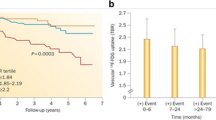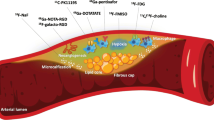Abstract
Inflammation plays a major pathogenetic role in the development of atherosclerotic plaques and related thromboembolic events. The identification of vulnerable plaques is of the utmost importance, as this may allow the implementation of more effective preventive and therapeutic interventions. Fluorodeoxyglucose positron emission tomography (FDG-PET) has been shown to be useful for tracing inflammation within plaques. However, its relationship to immunohistochemical findings in different territories of the peripheral circulation was not completely elucidated. We aimed to determine whether plaque inflammation could be measured by PET in combination with computer tomography (CT) using FDG and what is the relationship between FDG uptake and immunohistochemical findings in the removed atherosclerotic lesions of the femoral and carotid arteries. The study included 31 patients, 21 patients with high-grade stenosis of the internal carotid artery (ICA) and 10 patients with occlusion of the common femoral artery (CFA), all of whom underwent endarterectomy. Before endarterectomy in all patients, FDG-PET/CT imaging was performed. FDG uptake was measured as the maximum blood—normalized standardized uptake value, known as the target to background ratio (TBR max). TBR max amounted to 1.72 ± 0.8, and in patients with ICA, stenosis was not significantly different from patients with CFA occlusion. Immunohistochemical and morphometric analyses of the plaques obtained at endarterectomy showed that the density of T lymphocytes and macrophages (number of cells per square millimeter) was significantly higher in subjects with stenosis of the ICA than in subjects with occlusion of the femoral arteries: lymphocytes, 1.26 ± 0.21 vs. 0.77 ± 0.29; p = 0.02 and macrophages, 1.01 ± 0.18 vs. 0.69 ± 0.23; p = 0.003. In the whole group of patients, the density of inflammatory cells significantly correlated with FDG uptake represented by PET-TBR max: T lymphocytes, r = 0.60; p < 0.01 and macrophages, r = 0.65; p < 0.01. The results of our study show that FDG uptake is related to the accumulation of inflammatory cells in atherosclerotic lesions. This finding suggests that FDG uptake reflects the severity of atherosclerotic vessel wall inflammation, and in stenotic lesions, it could be an indicator of their vulnerability. However, data from large outcome studies is needed to estimate the usefulness of this technique in identifying the most dangerous atherosclerotic lesions and vulnerable patients.



Similar content being viewed by others
References
Grundy, S.M., J.I. Cleeman, C.N. Merz, H.B. Brewer, L.T. Clark, D.B. Hunninghake, R.C. Pasternak, S.C. Smith, N.J. Stone, National Heart Ln, and Blood Institute, Foundation ACoC, and Association AH. 2004. Implications of recent clinical trials for the National Cholesterol Education Program Adult Treatment Panel III guidelines. Circulation 110: 227–239.
Naghavi, M., P. Libby, E. Falk, S.W. Casscells, S. Litovsky, J. Rumberger, J.J. Badimon, C. Stefanadis, P. Moreno, G. Pasterkamp, Z. Fayad, P.H. Stone, S. Waxman, P. Raggi, M. Madjid, A. Zarrabi, A. Burke, C. Yuan, P.J. Fitzgerald, D.S. Siscovick, C.L. de Korte, M. Aikawa, K.E. Juhani Airaksinen, G. Assmann, C.R. Becker, J.H. Chesebro, A. Farb, Z.S. Galis, C. Jackson, I.K. Jang, W. Koenig, R.A. Lodder, K. March, J. Demirovic, M. Navab, S.G. Priori, M.D. Rekhter, R. Bahr, S.M. Grundy, R. Mehran, A. Colombo, E. Boerwinkle, C. Ballantyne, W. Insull, R.S. Schwartz, R. Vogel, P.W. Serruys, G.K. Hansson, D.P. Faxon, S. Kaul, H. Drexler, P. Greenland, J.E. Muller, R. Virmani, P.M. Ridker, D.P. Zipes, P.K. Shah, and J.T. Willerson. 2003. From vulnerable plaque to vulnerable patient: a call for new definitions and risk assessment strategies: Part I. Circulation 108: 1664–1672.
Schwartz, S.M., Z.S. Galis, M.E. Rosenfeld, and E. Falk. 2007. Plaque rupture in humans and mice. Arteriosclerosis, Thrombosis, and Vascular Biology 27: 705–713.
Bogiatzi, C., M.S. Cocker, R. Beanlands, and J.D. Spence. 2012. Identifying high-risk asymptomatic carotid stenosis. Expert Opinion on Medical Diagnostics 6: 139–151.
Rudd, J.H., K.S. Myers, S. Bansilal, J. Machac, C.A. Pinto, C. Tong, A. Rafique, R. Hargeaves, M. Farkouh, V. Fuster, and Z.A. Fayad. 2008. Atherosclerosis inflammation imaging with 18F-FDG PET: carotid, iliac, and femoral uptake reproducibility, quantification methods, and recommendations. Journal of Nuclear Medicine 49: 871–878.
Hubalewska-Dydejczyk, A., T. Stompór, M. Kalembkiewicz, M. Krzanowski, R. Mikolajczak, A. Sowa-Staszczak, B. Tabor-Ciepiela, U. Karczmarczyk, B. Kusnierz-Cabala, and W. Sulowicz. 2009. Identification of inflamed atherosclerotic plaque using 123 I-labeled interleukin-2 scintigraphy in high-risk peritoneal dialysis patients: a pilot study. Peritoneal Dialysis International 29: 568–574.
Ridker, P.M., N. Rifai, M. Clearfield, J.R. Downs, S.E. Weis, J.S. Miles, and A.M. Gotto. 2001. Investigators AFTCAPS: measurement of C-reactive protein for the targeting of statin therapy in the primary prevention of acute coronary events. New England Journal of Medicine 344: 1959–1965.
Nighoghossian, N., L. Derex, and P. Douek. 2005. The vulnerable carotid artery plaque: current imaging methods and new perspectives. Stroke 36: 2764–2772.
Blockmans, D., A. Maes, S. Stroobants, J. Nuyts, G. Bormans, D. Knockaert, H. Bobbaers, and L. Mortelmans. 1999. New arguments for a vasculitic nature of polymyalgia rheumatica using positron emission tomography. Rheumatology (Oxford) 38: 444–447.
Tawakol, A., R.Q. Migrino, G.G. Bashian, S. Bedri, D. Vermylen, R.C. Cury, D. Yates, G.M. LaMuraglia, K. Furie, S. Houser, H. Gewirtz, J.E. Muller, T.J. Brady, and A.J. Fischman. 2006. In vivo 18F-fluorodeoxyglucose positron emission tomography imaging provides a noninvasive measure of carotid plaque inflammation in patients. Journal of the American College of Cardiology 48: 1818–1824.
Mehta, N.N., D.A. Torigian, J.M. Gelfand, B. Saboury, and A. Alavi. 2012. Quantification of atherosclerotic plaque activity and vascular inflammation using [18-F] fluorodeoxyglucose positron emission tomography/computed tomography (FDG-PET/CT). J Vis Exp 63: 3777.
Rudd, J.H., E.A. Warburton, T.D. Fryer, H.A. Jones, J.C. Clark, N. Antoun, P. Johnström, A.P. Davenport, P.J. Kirkpatrick, B.N. Arch, J.D. Pickard, and P.L. Weissberg. 2002. Imaging atherosclerotic plaque inflammation with [18F]-fluorodeoxyglucose positron emission tomography. Circulation 105: 2708–2711.
Tahara, N., H. Kai, S. Yamagishi, M. Mizoguchi, H. Nakaura, M. Ishibashi, H. Kaida, K. Baba, N. Hayabuchi, and T. Imaizumi. 2007. Vascular inflammation evaluated by [18F]-fluorodeoxyglucose positron emission tomography is associated with the metabolic syndrome. Journal of the American College of Cardiology 49: 1533–1539.
Graebe, M., S.F. Pedersen, L. Borgwardt, L. Højgaard, H. Sillesen, and A. Kjaer. 2009. Molecular pathology in vulnerable carotid plaques: correlation with [18]-fluorodeoxyglucose positron emission tomography (FDG-PET). European Journal of Vascular and Endovascular Surgery 37: 714–721.
Daugherty, A., and D.L. Rateri. 2002. T lymphocytes in atherosclerosis: the yin-yang of Th1 and Th2 influence on lesion formation. Circulation Research 90: 1039–1040.
Bushart, G.B., U. Vetter, and W. Hartmann. 1993. Glucose transport during cell cycle in IM9 lymphocytes. Hormone and Metabolic Research 25: 210–213.
Shozushima, M., R. Tsutsumi, K. Terasaki, S. Sato, R. Nakamura, and K. Sakamaki. 2003. Augmentation effects of lymphocyte activation by antigen-presenting macrophages on FDG uptake. Annals of Nuclear Medicine 17: 555–560.
Gallagher, B.M., J.S. Fowler, N.I. Gutterson, R.R. MacGregor, C.N. Wan, and A.P. Wolf. 1978. Metabolic trapping as a principle of oradiopharmaceutical design: some factors resposible for the biodistribution of [18F] 2-deoxy-2-fluoro-d-glucose. Journal of Nuclear Medicine 19: 1154–1161.
Menezes, L.J., C.W. Kotze, O. Agu, T. Richards, J. Brookes, V.J. Goh, M. Rodriguez-Justo, R. Endozo, R. Harvey, S.W. Yusuf, P.J. Ell, and A.M. Groves. 2011. Investigating vulnerable atheroma using combined (18)F-FDG PET/CT angiography of carotid plaque with immunohistochemical validation. Journal of Nuclear Medicine 52: 1698–1703.
Rudd, J.H., F. Hyafil, and Z.A. Fayad. 2009. Inflammation imaging in atherosclerosis. Arteriosclerosis, Thrombosis, and Vascular Biology 29: 1009–1016.
Cocker, M.S., B. Mc Ardle, J.D. Spence, C. Lum, R.R. Hammond, D.C. Ongaro, M.A. McDonald, R.A. Dekemp, J.C. Tardif, and R.S. Beanlands. 2012. Imaging atherosclerosis with hybrid [(18)F]fluorodeoxyglucose positron emission tomography/computed tomography imaging: what Leonardo da Vinci could not see. Journal of Nuclear Cardiology 19: 1211–1225.
Arauz, A., L. Hoyos, M. Zenteno, R. Mendoza, and E. Alexanderson. 2007. Carotid plaque inflammation detected by 18F-fluorodeoxyglucose-positron emission tomography. Pilot study. Clinical Neurology and Neurosurgery 109: 409–412.
Rominger, A., T. Saam, S. Wolpers, C.C. Cyran, M. Schmidt, S. Foerster, K. Nikolaou, M.F. Reiser, P. Bartenstein, and M. Hacker. 2009. 18F-FDG PET/CT identifies patients at risk for future vascular events in an otherwise asymptomatic cohort with neoplastic disease. Journal of Nuclear Medicine 50: 1611–1620.
Wassélius, J.A., S.A. Larsson, and H. Jacobsson. 2009. FDG-accumulating atherosclerotic plaques identified with 18F-FDG-PET/CT in 141 patients. Molecular Imaging and Biology 11: 455–459.
Tahara, N., H. Kai, M. Ishibashi, H. Nakaura, H. Kaida, K. Baba, N. Hayabuchi, and T. Imaizumi. 2006. Simvastatin attenuates plaque inflammation: evaluation by fluorodeoxyglucose positron emission tomography. Journal of the American College of Cardiology 48: 1825–1831.
Lee, S.J., Y.K. On, E.J. Lee, J.Y. Choi, B.T. Kim, and K.H. Lee. 2008. Reversal of vascular 18F-FDG uptake with plasma high-density lipoprotein elevation by atherogenic risk reduction. Journal of Nuclear Medicine 49: 1277–1282.
Chen, W., G.G. Bural, D.A. Torigian, D.J. Rader, and A. Alavi. 2009. Emerging role of FDG-PET/CT in assessing atherosclerosis in large arteries. European Journal of Nuclear Medicine and Molecular Imaging 36: 144–151.
Rudd, J.H., K.S. Myers, S. Bansilal, J. Machac, A. Rafique, M. Farkouh, V. Fuster, and Z.A. Fayad. 2007. (18)Fluorodeoxyglucose positron emission tomography imaging of atherosclerotic plaque inflammation is highly reproducible: implications for atherosclerosis therapy trials. Journal of the American College of Cardiology 50: 892–896.
Davies, J.R., D. Izquierdo-Garcia, J.H. Rudd, N. Figg, H.K. Richards, J.L. Bird, F.I. Aigbirhio, A.P. Davenport, P.L. Weissberg, T.D. Fryer, and E.A. Warburton. 2010. FDG-PET can distinguish inflamed from non-inflamed plaque in an animal model of atherosclerosis. International Journal of Cardiovascular Imaging 26: 41–48.
Gaemperli, O., J. Shalhoub, D.R. Owen, F. Lamare, S. Johansson, N. Fouladi, A.H. Davies, O.E. Rimoldi, and P.G. Camici. 2012. Imaging intraplaque inflammation in carotid atherosclerosis with 11C-PK11195 positron emission tomography/computed tomography. European Heart Journal 33: 1902–1910.
Silvola, J.M., A. Saraste, I. Laitinen, N. Savisto, V.J. Laine, S.E. Heinonen, S. Ylä-Herttuala, P. Saukko, P. Nuutila, A. Roivainen, and J. Knuuti. 2011. Effects of age, diet, and type 2 diabetes on the development and FDG uptake of atherosclerotic plaques. JACC. Cardiovascular Imaging 4: 1294–1301.
Bybel, B., I.D. Greenberg, J. Paterson, J. Ducharme, and W.D. Leslie. 2011. Increased F-18 FDG intestinal uptake in diabetic patients on metformin: a matched case–control analysis. Clinical Nuclear Medicine 36: 452–456.
Hiroya, N. 2008. Abstract 5825: association between patterns of FDG uptake and arterial wall calcification on PET/CT and atherogenic risk factors in healthy subjects. Circulation 118: S_1012.
Bucerius, J., R. Duivenvoorden, V. Mani, C. Moncrieff, J.H. Rudd, C. Calcagno, J. Machac, V. Fuster, M.E. Farkouh, and Z.A. Fayad. 2011. Prevalence and risk factors of carotid vessel wall inflammation in coronary artery disease patients: FDG-PET and CT imaging study. JACC. Cardiovascular Imaging 4: 1195–1205.
Tawakol, A., Z.A. Fayad, R. Mogg, A. Alon, M.T. Klimas, H. Dansky, S.S. Subramanian, A. Abdelbaky, J.H. Rudd, M.E. Farkouh, I.O. Nunes, C.R. Beals, and S.S. Shankar. 2013. Intensification of statin therapy results in a rapid reduction in atherosclerotic inflammation: results of a multicenter fluorodeoxyglucose-positron emission tomography/computed tomography feasibility study. Journal of the American College of Cardiology 62: 909–917.
Conflict of Interest
No conflict of interest to declare.
Author information
Authors and Affiliations
Corresponding author
Rights and permissions
About this article
Cite this article
Jezovnik, M.K., Zidar, N., Lezaic, L. et al. Identification of Inflamed Atherosclerotic Lesions In Vivo Using PET-CT. Inflammation 37, 426–434 (2014). https://doi.org/10.1007/s10753-013-9755-3
Published:
Issue Date:
DOI: https://doi.org/10.1007/s10753-013-9755-3




